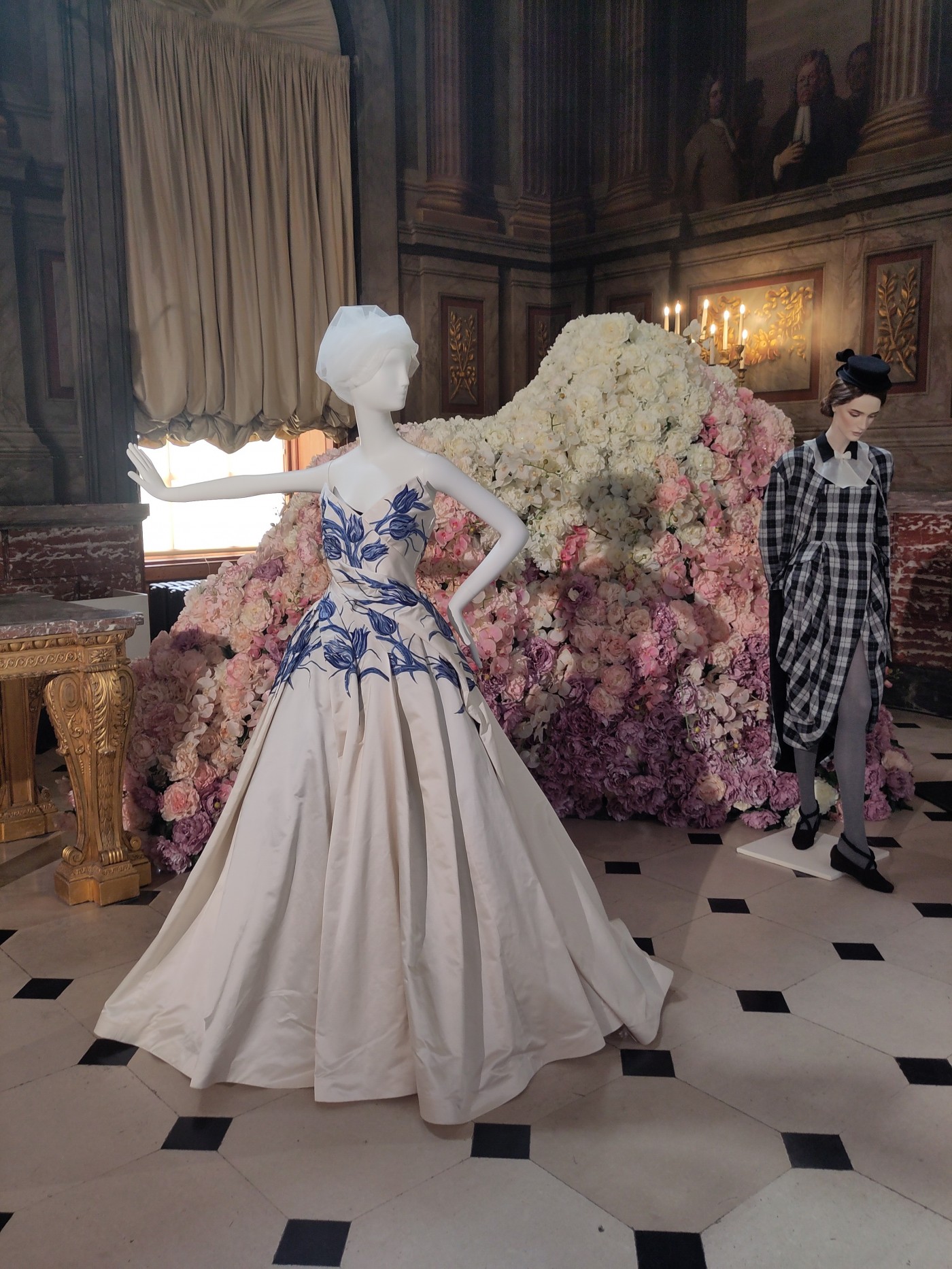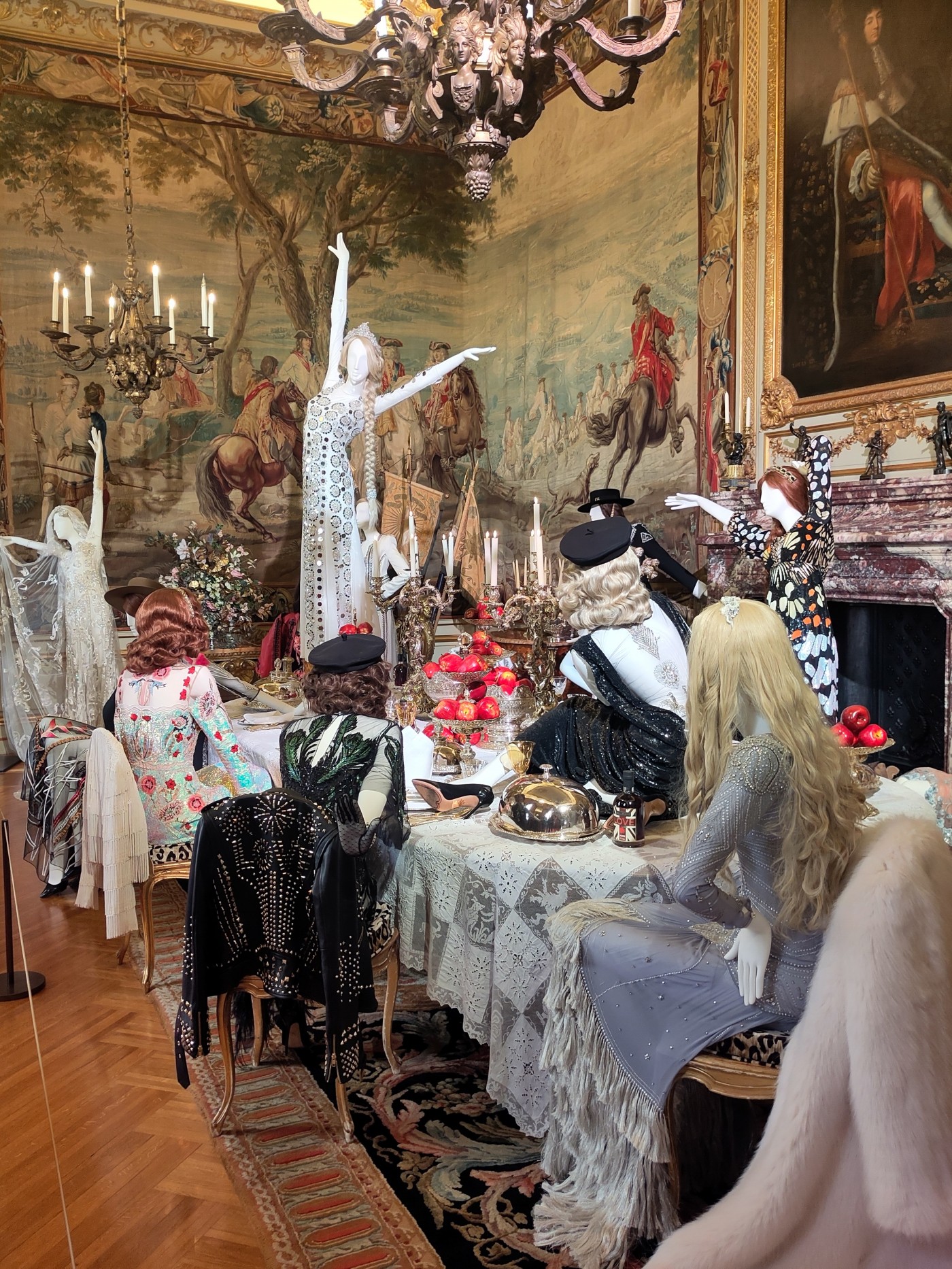- youtube
- bluesky
- Home
- About
- Costume Journal
- Membership
- Conference & Events
- Grants & Awards
- News & Social
In this week’s blog post, Costume Society News Editor Babette Radclyffe-Thomas reviews Blenheim Palace’s first fashion exhibition, Icons of British Fashion.
Blenheim Palace, a 300-year-old UNESCO World Heritage Site in Oxfordshire, has recently opened ‘Icons of British Fashion’.
Home to the Dukes of Marlborough since 1705, set in over 2,000 acres of ‘Capability’ Brown landscaped parkland and designed by Vanbrugh in the Baroque style, Blenheim Palace is also the birthplace of one of Britain’s most famous leaders, Sir Winston Churchill and it was his father who described the vista, on entering the Estate from the village of Woodstock, as the ‘finest view in England’.
“I have always wanted to do a fashion exhibition at the Palace and the recent popularity of the amazing exhibitions at the V&A Museum, London showed that there is a public appetite for fashion and design. We are an iconic British location and welcome visitors from all over the world. It felt like a natural pairing to celebrate iconic British Fashion design and to be able to share it with our international visitors.” Kate Ballenger, Keeper of Palace and Collections at Blenheim Palace tells the Costume Society in an exclusive interview.
The largest exhibition in the palace’s history, a range of British designers, milliners, shoe designers and brands are shown amongst the palace’s own priceless collections. Interacting with the palace’s historic rooms, mannequins pose among portraits, sculptures and artifacts, each space along the visitor route of this historic palace is dedicated to one creative.
“The Palace provides a beautiful backdrop for any exhibition, but this one does feel like it has breathed new life into the building. Anything we do in the Palace must be done carefully and protecting the building and collection is always our priority. We are temporary custodians of this amazing place and have a duty to share it, but always in a way that does not permanently alter it in any way,” said Ballenger.
“We have nearly 400 items on display and they are all loans. They come from a mix of the designers’ archives, loans from clients and excitingly some new designs created specifically for the exhibition. We also have a number of looks from Fashion Museum Bath who have been incredibly supportive of the exhibition,” said Ballenger.
Explaining her approach to selecting the designers, Ballenger shares that she was spoilt for choice. “There are so many incredible designers in Britain, we could have filled the Palace twice over. Some of the world’s biggest fashion icons are British and have designed looks that have held cultural significance and influenced thousands of people. British fashion, in particular, has been a big influence on global fashion for many years. We wanted to showcase a broad spectrum of designers and brands to illustrate the diversity and creativity of the British Fashion industry. As curator though, I did have to narrow the selection.
I am Australian and have followed British and European since I was young, from afar in awe. In 1988 I was giddy with excitement for the biggest event in Australian Fashion history to date – the Bicentennial wool collection. The best international designers were invited to design collections using Australian wool and inspired by Australia. The designers included Versace, Claude Montana, Kenzo and many others, but I was particular mesmerised by the collections of Bruce Oldfield and Jean Muir. I must have watched the show 20 times and loved every minute. Stephen Jones is widely considered one of the most important, talented and prolific milliners of the late 20th and early 21st century and we have had the privilege of working with him previously. Vivienne Westwood, Zandra Rhodes and Stella McCartney are so iconic it was an easy choice and they have all visited the Palace previously. Terry de Havilland, Lulu Guinness and Alice Temperley are quintessentially British and their creations are works of art in their own right. Barbour have a long heritage and have been worn by the family at Blenheim for generations. Turnbull and & Asser dressed our own fashion icon Winston Churchill and created his iconic siren suit,” Ballenger said.
From the choice of mannequin and use of music to the styling and content on show, each room has its distinct ambiance. “The plan was to invite the designers and brands to view the Palace and chose the room they most responded to. We had to have a ‘first come, first served’ approach and once a room had been chosen, it was reserved for that designer. Fortunately none of them chose the same room!” Ballenger shares.
Starting in the Great Hall, as visitors wind their way through the route, each historic room is dedicated to one designer or brand. Starting with Dame Vivienne Westwood’s work with Andreas Kronthaler, visitors can see the brand’s signature corsets, capes and striking gowns including 2010’s Dress of the Year on loan from Fashion Museum, Bath; a pale green ribbed shot silk dress worn with clear plastic shoes, black plastic sunglasses and gold-coloured hoop earrings by Dame Vivienne Westwood.
Next are gowns by Jean Muir that adorn an historic staircase, including Dress of the Year 1979’s black silk jersey dress, black tailored leather jacket and black beret by Jean Muir as well as black suede leather shoes by Manolo Blahnik for Zapata, on loan from Fashion Museum, Bath.
The following room show shoes, moodboards, design sketches, photos and much more from shoe designer Terry Havilland. There are several Havilland archive pieces, including a fun pair of bespoke, hand-painted Zap Pow art shoes that were created for the late Amy Winehouse’s UK tour.
In the Green Drawing Room, Bruce Oldfield took inspiration from Cecil Beaton’s 1948 photograph of a group of society women wearing Charles James gowns. Showcasing 10 of his designs from the last decade, the room celebrates his namesake brand’s grand occasion wear.
The following room is the Red Drawing Room and is taken over by Zandra Rhodes in a joyful celebration of textile prints and patterns. One of the most striking rooms, the room is amidst a fabulous fashion party with gowns from her 50-year career are displayed on vintage mannequins. “Zandra Rhodes was the first to choose and selected the beautiful Red Drawing Room. She had attended a party at the Palace in the early 1970’s with Mick and Bianca Jagger (with Bianca dressed in one of Zandra’s designs) and wanted to recreate that glamorous memory,” said Ballenger. This room takes its name from the red silk that adorns the walls and furniture, is also known as the entertainment room, which is fitting for the party ambiance created by Rhodes.
In the next room, the great outdoors and the surrounding countryside come indoors to celebrate Barbour’s iconic waxed jackets. Patterned foliage covers the room, innovative mannequins are made out of sticks, while a photo wall shows their jackets in action on farmers to actors.
A lip and heart filled room is of course Lulu Guiness’ room where for the first time a wide range of handbags from the designer’s archive are on show. Displayed on rotating trees, handbags hang off branches, adorn the surfaces, and play among over sized fabric flowers. There are even some pieces crafted from recycled materials that were created especially for this exhibition.
In one room, Stephen Jones harks back to 1954, when Christian Dior showed his couture at the Palace, by showing three outfits with millinery from the creative directors he has collaborated with over the last 30 years. There is also a smoking cap created especially for the exhibition and inspired by one of the palace’s famous residents, Winston Churchill. As 2024 marks the 150th anniversary of Churchill’s birth in Blenheim Palace, his family’s ancestral home, and visitors can also see an original Churchill Siren Suits, loaned by Turnbull & Asser.
One room hosts a riotous dinner party designed by Alice Temperley, before visitors experience the last room, the Long Library. This striking room hosts floor to ceiling bookshelves, and a large organ at one end. When visitors enter the room they can get up close to innovative eco-friendly materials that the designer is renowned for championing, and the majority of the expansive room is taken over by a runway show of mannequins in a wide array of the designer’s pieces.
“The Library is a huge room at 180 feet long so is a big space to fill. We wanted to finish with a strong message regarding the future of fashion and this room allowed for us to be able to share with our visitors all of the exciting innovations Stella has developed to minimise impact on the environment as well as her amazing designs,” said Ballenger.
The palace is a fabulous setting for a fashion exhibition highlighting diverse fashion and accessory designers, and we can't wait to see what they do next.
The exhibition runs until 30 June, 2024.
Image gallery







